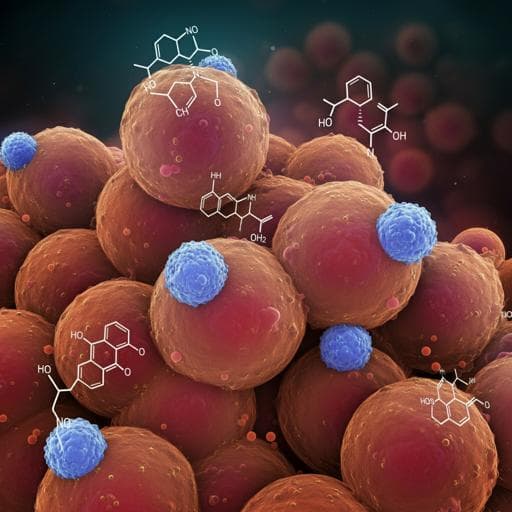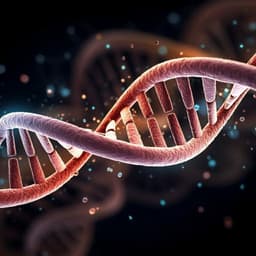
Medicine and Health
Sex differences in adipose insulin resistance are linked to obesity, lipolysis and insulin receptor substrate 1
P. Arner, N. Viguerie, et al.
This study delves into the sex differences in adipose tissue insulin resistance, highlighting how obesity affects men and women differently. Conducted by notable researchers including Peter Arner and Nathalie Viguerie, the findings reveal that in obesity, men face greater adipose insulin resistance, marked by lower insulin sensitivity and altered lipolysis processes.
~3 min • Beginner • English
Introduction
The study investigates whether known sex differences in insulin resistance extend to adipose tissue. Men develop type 2 diabetes at younger ages and lower fat mass than women, and women typically show greater insulin sensitivity in liver and muscle. Adipose tissue is pivotal in energy homeostasis through insulin’s regulation of fatty acid metabolism—suppressing lipolysis and stimulating triglyceride synthesis. Impaired adipose insulin action elevates circulating fatty acids and can drive systemic insulin resistance. The authors hypothesized that adipose tissue contributes to sex dimorphism in insulin resistance and examined this using a large cohort and mechanistic adipocyte assays, with particular consideration of obesity’s strong impact on insulin action.
Literature Review
Prior literature indicates women generally have higher insulin sensitivity in skeletal muscle and liver than men. Adipose tissue insulin action is often assessed by complex methods; the AdipolR index (fasting insulin × fasting free fatty acids) serves as a validated surrogate correlating with in vivo and in vitro adipose insulin action. Previous transcriptomic studies reported limited sex differences in adipose gene expression, mainly in pathways of inflammation, adipogenesis, and mitochondrial function, but have not specifically linked sex differences to canonical insulin signaling genes in obesity. This study builds on these findings by focusing on functional adipocyte assays and targeted analysis of early insulin signaling components.
Methodology
Design and cohorts: Cross-sectional analyses using two cohorts. KAROLINSKA cohort: 2343 women and 787 men (adult volunteers, Stockholm area, Sweden) with AdipolR data collected 1993–2020. Exclusions: type 1 diabetes, acute severe disease. Participants fasted overnight and underwent standardized clinical assessments. Adipose tissue biopsies (abdominal subcutaneous) were obtained from those with obesity (BMI ≥30 kg/m²) when sufficient tissue allowed metabolic assays. Physical activity was self-reported on a validated 4-point scale. HOMA-IR was calculated from fasting glucose and insulin. AdipolR was calculated as fasting insulin (pmol/L) × fasting fatty acids (mmol/L).
DiOGenes cohort: 234 women and 115 men with obesity from a pan-European randomized dietary study; used for adipose tissue gene expression analyses. In 179 women and 109 men, IRS1/IRS2 expression was validated by RT-qPCR.
Adipocyte functional assays (KAROLINSKA, obesity subgroup): Subcutaneous adipocytes were isolated by collagenase digestion. Lipolysis: cells incubated 2 h at 37°C with glucose, albumin, adenosine deaminase, and 1 mmol/L 8-bromo-cAMP, with graded insulin (0–70 nmol/L). Glycerol release indicated lipolysis; basal lipolysis measured without insulin or lipolytic agents. Lipogenesis: cells incubated 2 h with 3-3H-glucose tracer and graded insulin (0–70 nmol/L); incorporation of glucose into lipids quantified. Insulin effects expressed as relative ratios (with vs without insulin). Sensitivity defined as pD2 (−log10 EC50); responsiveness defined as maximal percentage effect. Lipolysis/lipogenesis assays prioritized lipogenesis when incomplete datasets occurred.
Gene expression (DiOGenes, obesity): Total RNA extracted from abdominal subcutaneous adipose tissue; RNA-seq performed (Illumina HiSeq 2000, paired-end 100 nt). Reads mapped to GRCh37 using STAR; counts via GenomicAlignments; annotation via GRCh37.75/AnnotationDbi. Log2-transformed relative expression analyzed for 17 canonical insulin signaling genes and 10 genes related to basal lipolysis. Validation by RT-qPCR for IRS1 and IRS2 (TaqMan assays) normalized to GUSB.
Statistics: Non-normal primary endpoints summarized as medians with IQR; Wilcoxon two-sample tests for group comparisons. ANCOVA used to assess sex effects adjusting for age, BMI or % body fat, and fasting glucose; site effects evaluated in DiOGenes. Bonferroni correction applied for gene expression (p < 0.00185 for 27 tests). Spearman correlation assessed % body fat vs antilipolysis pD2 with sex interaction by ANCOVA. Power analysis indicated adequate power for subgroup analyses.
Key Findings
- Adipose insulin resistance by AdipolR:
- No sex difference without obesity (Fig. 1A).
- With obesity (BMI ≥30 kg/m²), men had significantly higher AdipolR than women (p < 0.0001; Fig. 1B).
- The higher AdipolR in men persisted across obesity subgroups: physically active and sedentary; with and without cardiometabolic disease; with and without nicotine use (all p ≤ 0.0003; Fig. 1C–H).
- Adipocyte insulin action (obesity subgroup):
- Antilipolysis: Men exhibited markedly reduced insulin sensitivity; pD2 about one log unit lower, corresponding to ~10-fold higher EC50 (p < 0.0001). Maximal antilipolytic responsiveness ~10% lower in men (p = 0.0005) (Fig. 2).
- Lipogenesis: No sex differences in insulin sensitivity (pD2, p = 0.26) or responsiveness (p = 0.18) (Fig. 2).
- pD2 for antilipolysis correlated weakly but significantly with % body fat (Spearman rho = 0.32, p < 0.0001) with a significant sex interaction (ANCOVA F = 5.2; p = 0.023).
- Basal lipolysis (obesity): Approximately two-fold higher in men vs women, expressed per g lipid and per 10^7 adipocytes (both p < 0.0001; Table 2).
- Adipose gene expression (obesity):
- Among 27 examined genes (17 insulin signaling + 10 basal lipolysis-related), only IRS1 showed a significant sex difference after Bonferroni correction, with lower expression in men (RNA-seq p < 0.0001/0.0002 depending on table; Table 1).
- RT-qPCR validation: IRS1 mRNA ~60% higher in women than men (p < 0.0001); IRS2 showed no sex difference.
- Site interactions were present, but sex remained a strong independent predictor of IRS1 expression (ANCOVA F ≈ 15–17; p ≤ 0.0002).
- Other genes with nominal sex differences (Bonferroni-significant among basal lipolysis-related): higher expression in men for CIDEA (p = 0.0002), PDE3B (p < 0.0001), and androgen (testosterone) receptor (p = 0.0004) (Table 2).
- Multivariable adjustment: Sex remained an independent contributor to AdipolR, antilipolysis pD2 and responsiveness, and IRS1 expression after adjusting for age, fasting glucose, BMI or % body fat (F = 10–34; p ≤ 0.002).
Discussion
The findings demonstrate that sex differences in insulin resistance involve adipose tissue specifically in the context of obesity. While non-obese men and women did not differ by AdipolR, men with obesity displayed greater adipose insulin resistance across multiple subgroups, independent of age, BMI/% fat, fasting glucose, physical activity, nicotine use, or cardiometabolic disease. Mechanistically, the principal dimorphism was in the antilipolytic arm of adipocyte insulin action: women had approximately 10-fold greater insulin sensitivity for suppression of lipolysis, with a modestly higher maximal effect. In contrast, insulin-stimulated lipogenesis did not differ by sex. Because pD2 reflects proximal signaling events, these results point to early insulin signaling steps as a key locus of sex differences. Consistently, adipose IRS1 expression was lower in men by RNA-seq and ~60% higher in women by RT-qPCR, implicating IRS1 as a candidate mediator of reduced antilipolytic insulin action in men with obesity. Additionally, men exhibited a two-fold elevation in basal lipolysis, which may further compromise insulin’s ability to suppress fatty acid release, contributing to systemic insulin resistance. Although nominal sex differences in CIDEA, PDE3B, and androgen receptor expression were observed, these did not fully account for the metabolic phenotype, suggesting that IRS1-related signaling and other regulatory mechanisms likely predominate. The observations support an organ- and pathway-specific sex dimorphism in insulin action relevant to T2DM risk in obesity.
Conclusion
In obesity, men exhibit greater adipose tissue insulin resistance than women, driven primarily by reduced insulin-mediated suppression of adipocyte lipolysis, higher basal lipolysis rates, and lower adipose tissue expression of IRS1. These results highlight early insulin signaling, particularly IRS1, as a potential mechanistic contributor to sex differences in metabolic risk. Future research should include prospective studies to establish causality, assessment of IRS1 protein abundance and phosphorylation, exploration of depot-specific adipose differences, and evaluation of targeted lifestyle or pharmacologic interventions to improve adipose insulin sensitivity—especially in men—to mitigate dysglycemia and T2DM risk.
Limitations
- Cross-sectional design limits causal inference; prospective validation is needed.
- Only abdominal subcutaneous adipose tissue was studied; depot-specific differences (visceral vs subcutaneous, other regions) were not assessed.
- Cohorts were not population-based; biopsy-based studies may involve selection bias.
- Sex imbalance with more women than men in both cohorts.
- Menstrual status was not assessed; however, insulin resistance is more closely linked to hyperandrogenemia than menstrual irregularity.
- AdipolR could not be compared between sites in DiOGenes due to strong inter-site variability in insulin and fatty acid assays; thus, AdipolR analyses were restricted to KAROLINSKA.
- Gene expression findings focus on mRNA; protein levels, post-translational modifications (e.g., IRS1 phosphorylation), and functional signaling were not directly measured.
Related Publications
Explore these studies to deepen your understanding of the subject.







